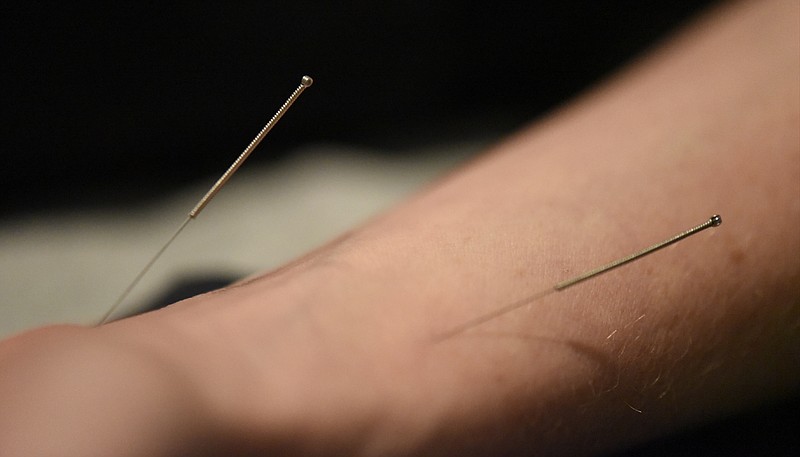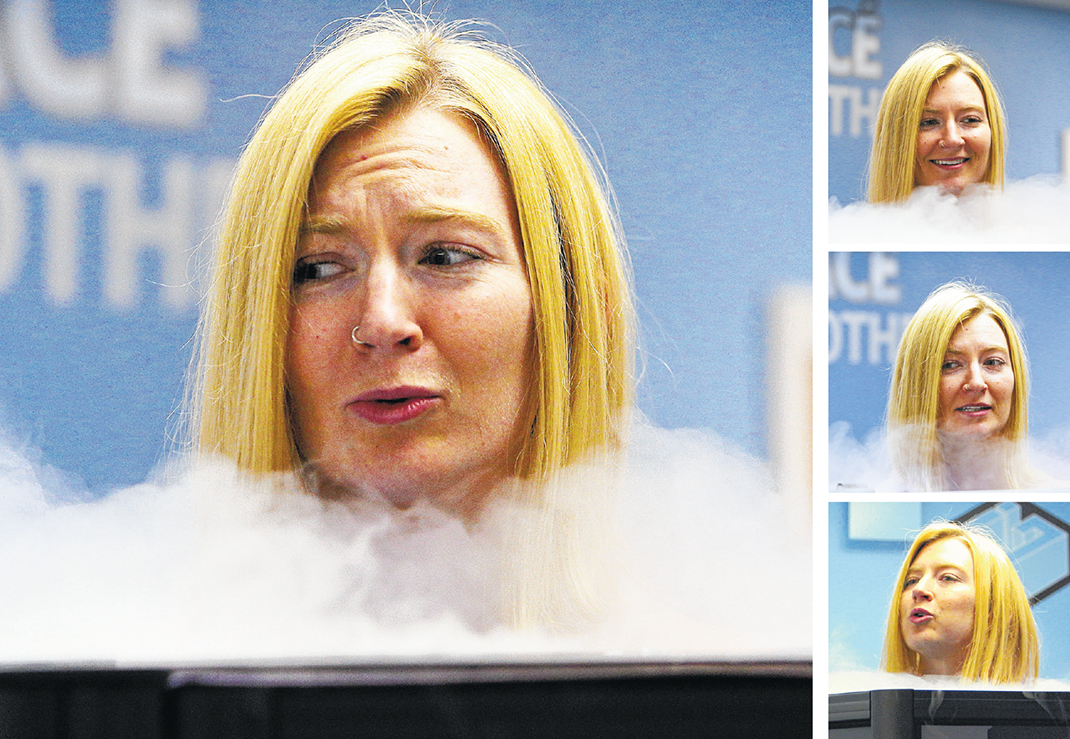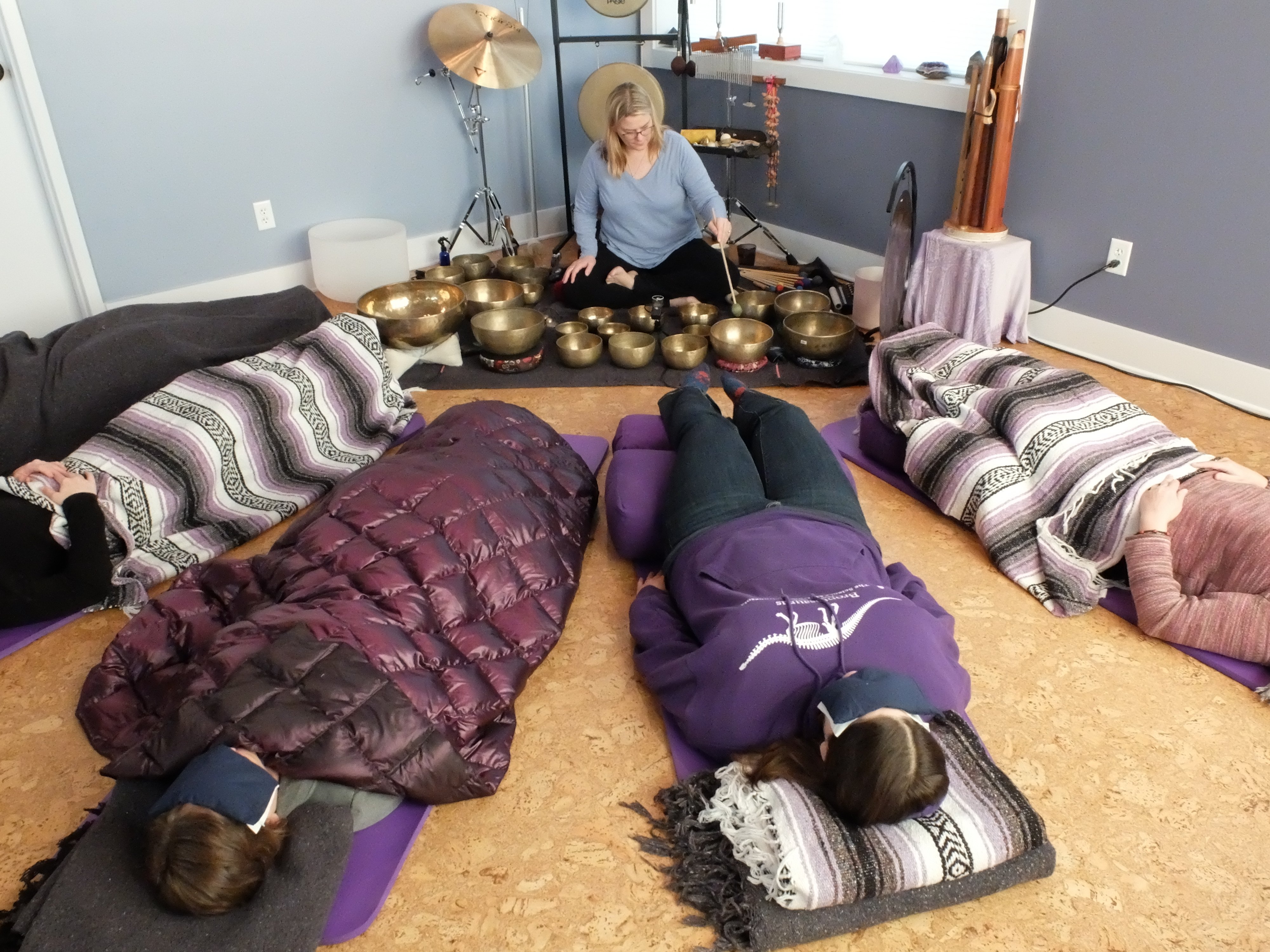The use of alternative medicine is growing.
According to the National Center for Complementary and Integrative Health, more than 30% of Americans now say they use a form of non-conventional healing such as herbs or yoga.
One reason for this growth is access to information, says Blake Storey, co-owner of Chattanooga Holistic Medicine, which specializes in Chinese medicine, among other natural therapies. When he first opened the practice in 2016, Storey had one patient. In 2019, he had more than a thousand.
"Dr. Google has a big influence on people's knowledge," Storey says.
Prior to the internet age, ailments and illnesses were diagnosed and treated through a "doctor-patient pipeline," says Storey. But now, a person can type symptoms into a search bar, add the word "natural," and connect to a myriad of alternative forms of medicine - from acupuncture to zang fu organ theory.
Many of these therapies are now available in Chattanooga, and more are sure to follow. To help prepare you for a new year of wellness and this ever-growing list of treatments, here are the ABCs of alternative healing.
_______
Acupuncture is traditional Chinese medicine dating back to 100 BCE, in which thin needles are inserted into the body. Ancient China believed that disease was caused by energy flow disruptions in the body, and that the needles helped stimulate and release those flows.
Western science now has other theories. One of the leading hypothesis is that the needles stimulate nerves which send signals to the brain to release certain hormones. Studies have shown acupuncture to be an effective treatment for headaches, asthma, fibromyalgia and more.
Connect locally: There are more than a dozen local places that practice acupuncture, from holistic centers to hospitals. Chattanooga Holistic Animal Institute even offers acupuncture for pets.
_______
Bodywork is an umbrella term for techniques involving therapeutic touch. Its most familiar form is massage. Others include reiki, reflexology and rolfing, which involves manipulating the connective tissues throughout the entire body. Bodywork is most commonly used to reduce stress, soreness or pain.
Connect locally: Like acupuncture, Chattanooga offers no shortage of places that practice bodywork. We suggest asking someone you know for a recommendation.
_______
Cryotherapy, also known as cold therapy, is a form of healing that exposes the whole body to extremely low temperatures, typically between minus-166 and minus-202 degrees Fahrenheit. The idea is built upon the more common practice of using ice packs or ice baths to treat some injuries - though proponents of the therapy say it also helps burn calories, increase energy, improve sleep and more.
Cold therapy was first introduced in Japan in the 1970s and was popularized in the U.S. in the 2010s. Comprehensive research on its risks and benefits are still inconclusive.
Connect locally: Norspring Center for Rejuvenation, 140 W. 14th St., or Glace Cryotherapy, 13 Kent St.
_______
Dance therapy is based on the idea that motion and emotion are connected. Sessions can range from ballroom dancing to simple stretching. Also known as movement therapy, it is used to treat a number of emotional, cognitive, physical or social issues, from body image issues to chronic pain.
_______
Electromagnetic therapy, also called pulsed electromagnetic field therapy or PEMF, works by directing mild electrical magnetic currents to targeted parts of the body. The idea is that these currents help restore weakened cells and can help treat pain, cancer or depression.
Nikola Tesla, most famous for his electric-powered automobiles, was an early pioneer of the therapy and invented the magnetic loop coil, which is now used in all PEMF devices.
Connect locally: Pulse Centers, 5811 Lee Hwy.
_______
Float therapy, also called restricted environmental stimulation therapy (REST), employs the use of an isolation tank to restrict all environmental stimuli, including gravity. The light-proof, sound-proof tank contains about a foot of water filled with Epsom salt for buoyancy. Both the water and the air are heated to the same temperature as one's skin.
Studies suggest that sensory deprivation helps induce deep relaxation, leading to a number of positive health benefits including helping with stress, depression, anxiety and muscle tension pains.
Connect locally: Lucidity Float and Wellness Center, 1405 Cowart St.
_______
Gut biome therapy, or microbiome therapy, is a still-evolving study that focuses on healthy gut bacteria, known as microbiota. Scientists believe that this bacteria can have a significant impact on health, affecting conditions that range from inflammatory bowel disease to cancer.
However, the gut's microbiome - made up of trillions of bacteria - is complex, and research is still needed to better understand how the microbiome links to certain conditions and how to use it restore one to health.
_______
Herbalism is the use of plants for medical treatments. The practice is prehistoric. In fact, many modern drugs are derived from plants, such as aspirin from willow bark and morphine from poppy.
Connect locally: Chattanooga boasts a number of places where one can find herbal supplements, but only a few places where one can consult with an on-site herbalist: Chattanooga Holistic Medicine, 1000 E. Third St., Suite 103; Hill City Acupuncture and Herbs, 50 Frazier Ave.; and The Wellness Tree, 2805 Dayton Blvd.
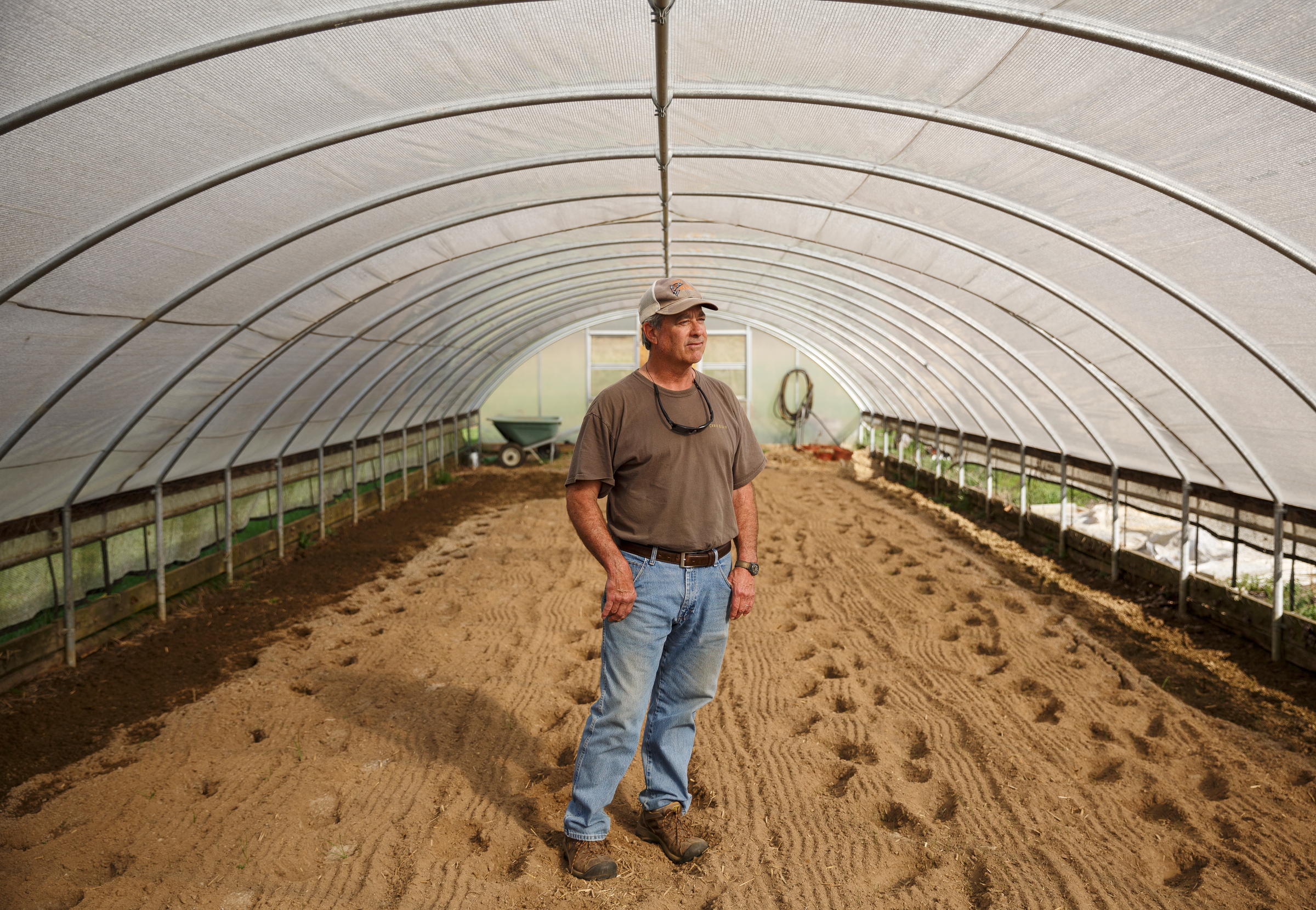 Steve Persinger poses for a portrait in a hoop house, where he and his wife Karen grow herbs like turmeric, at Rising Fawn Gardens on Friday, Feb. 23, 2018, in Rising Fawn, Tenn. Rising Fawn Gardens offers a yoga studio and corporate retreats in addition to growing wheat and herbs, but the only available internet access is via satellite, which has limited capability and speed compared to other broadband offerings. / Staff photo by Doug Strickland
Steve Persinger poses for a portrait in a hoop house, where he and his wife Karen grow herbs like turmeric, at Rising Fawn Gardens on Friday, Feb. 23, 2018, in Rising Fawn, Tenn. Rising Fawn Gardens offers a yoga studio and corporate retreats in addition to growing wheat and herbs, but the only available internet access is via satellite, which has limited capability and speed compared to other broadband offerings. / Staff photo by Doug Strickland_______
Intravenous vitamin therapy is a wellness trend that administers vitamins and minerals directly into the bloodstream via an IV drip. The treatment is commonly used to help hydrate, boost immunity or relieve symptoms of morning sickness or hangover; however, health claims are anecdotal as they have not yet been tested in clinical studies.
Connect locally: RevIVe Chattanooga, 518 Georgia Ave.
_______
Journaling, or more specifically proprioceptive writing, is a tool used to help improve mental and emotional clarity. Unlike other forms of journaling, proprioceptive writing involves the use of "auditory imagination," in which a person shifts to overhearing thoughts as if they were spoken rather than experiencing those thoughts as words in their own head.
In order to accomplish that shift, the practice instructs one to to find a space free of distractions, light a candle, play Baroque music, which has a rhythmic quality reflective of the human pulse, and write down his or her thoughts on unlined paper for 25 minutes.
Connect locally: Proprioceptive Writing Center, Southeast, 1401 Williams St.
_______
Kampo is traditional Chinese medicine adapted to Japanese culture. Many of those adaptations are found in Kampo's herbal formulas, which utilize a different basic collection of healing herbs and plants. Though the uniquely Japanese practice fell out of favor in the late 1800s, it has since been revived and is now taught in Japanese medical schools.
_______
Laughter yoga is a form of yoga that combines simulated laughter with breathing techniques. Science has long shown that laughter can reduce blood pressure and stress hormone levels, as well as increase one's general sense of well-being. And, more recent studies have shown that self-induced laughter provides the same benefits.
Connect locally: Toes Yoga Studio of Chattanooga, 3228 Brained Road.
_______
Music therapy is a holistic form of healing that uses sound, vibration or harmonics to treat the mind, body and soul. It may employ the use of gongs, singing bowls, tuning forks, flutes, drums, chimes, rattles, didgeridoos and acoustic vibrations to aid with deep relaxation, pain management, terminal illness, post-surgery healing and more. Music therapy, however, can take on many different expressions. One study found that listening to pop music helped reduce post-surgery pain in children.
Connect locally: Purple Sky Healing Arts, 625 E. Main St.
_______
Nature therapy refers to the use of the outdoors to improve a person's mental or physical health. One example is forest bathing, which is simply the practice of taking a walk through the forest while focusing on one's senses as triggered by the setting. Research shows this form of nature immersion can lower blood pressure, heart rates and stress hormones.
Connect locally: While there are countless places around town to get lost in the woods, local herbalist and psychotherapist Holli Richey has led coordinated forest bathing walks with Crabtree Farms and Reflection Riding.
_______
Orthopathy is more of a philosophy than a therapy. It stems from the Nature Cure movement, which promotes natural cures as healing methods. Followers of orthopathy believe that fasting, dieting and other holistic practices are all that is necessary to prevent disease.
_______
Prana healing is a form of energy medicine that involves treating a person's invisible energy field. Examples may include tapping, massaging, pinching or twisting specific energy points on the skin. Pranic therapy has been used to treat everything from asthma and ulcers to mental illness and multiple sclerosis. It is sometimes described as acupuncture without needles. Though the therapy is not clinically proven, a number of top U.S. medical research centers now offer some form of energy healing.
Connect locally: Purple Sky Healing Arts, 625 E. Main St.
_______
Qigong, pronounced chee-gong, is an ancient Chinese healing practice that integrates meditation, breathing and movement exercises. While somewhat similar to both tai chi and yoga, qigong is different in that it places more emphasis on the meditation than the movements. Studies have shown meditation to help reduce stress hormones, thus helping treat some stress-related conditions such as inflammation, fibromyalgia or irritable bowel syndrome.
Connect locally: Yin Yang House Acupuncture and Wellness Center, 7053 Lee Hwy.; Tai Chi @ St. Peters, 848 Ashland Terrace; SunBodywork, 6237 Vance Road.
_______
Red light therapy uses low-level red light transmitted through lasers or LED lights to address a myriad of issues, including collagen production, scar treatment, muscle repair, poor circulation and much more. Having been explored only since the mid-1990s, the therapy lacks extensive research, so it is largely considered experimental.
Connect locally: Chattanooga Wellness Natural Health Center, 6016 E. Brainerd Road.
_______
Saunas use dry heat to promote sweating, which has long been used as therapy. The latest trend is the use of infrared saunas. Unlike traditional saunas, which use fire or electricity to heat a small room to temperatures typically between 158 degrees and 212 degrees Fahrenheit, infrared saunas use light waves to heat a person's body rather than the entire room. Studies have shown saunas help release toxins, lower stress levels and improve cardiovascular health.
Connect locally: Sisu Sauna Studio, 26 E. Main St.
_______
Thalassotherapy is the use of seawater, sea products or shore climate to help rejuvenate and restore the skin and body. It has three main forms: hydrotherapy, involving saltwater; algotherapy, involving seaweed, algae or mud; and physiotherapy, involving water exercises.
_______
Unani medicine is a traditional South Asian system of healing. The practice is based on the belief that good health depends on the balance of elements in the body, and that those elements are present in four fluids: phlegm, blood, yellow bile and black bile. Therapies to treat elemental imbalances may include a number of other alternative forms of healing, including cupping, bloodletting, aromatherapy or massage.
_______
Vibroacoustic therapy uses musical vibrations and low-frequency sounds to "massage" deep parts of the body. The vibrations are emitted from a specially designed piece of furniture such as a recliner or table. Research indicates this type of "musical massage" may help reduce stress, decrease pain, lower blood pressure and even treat symptoms of Parkinson's disease.
Connect locally: Purple Sky Healing Arts, 625 E. Main St.
_______
Water therapy, in this case, does not refer to water aerobics. Rather, this wellness trend, also called morning water therapy, refers to the practice of drinking 1.5 liters of water, the equivalent of 5-6 glasses, upon waking. The idea is that drinking water on an empty stomach helps increase the body's ability to repair and regulate itself. Benefits include boosted immunity and metabolism, in addition to improved skin and hair health.
Though studies have not proven these claims, the benefits of hydration are well known. According to the U.S. Centers for Disease Control and Prevention, 43% of American adults drink less than 1.5 liters of water in a day.
_______
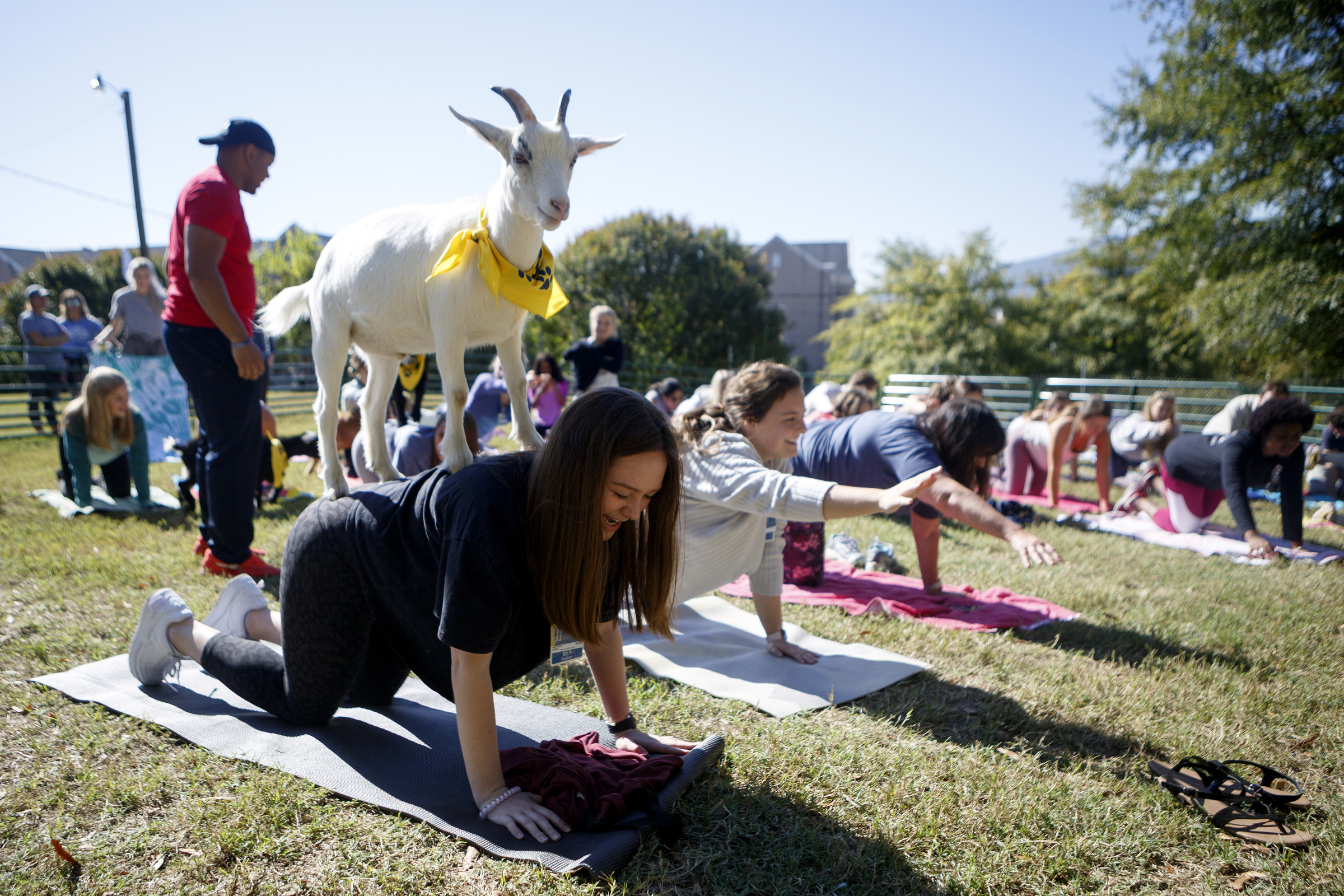 Staff photo by C.B. Schmelter / Hadyn Wilson, a junior nursing major, reacts as Clue the goat stands after being placed on her back during goat yoga at The House on the campus of the University of Tennessee at Chattanooga on Thursday, Oct. 24, 2019 in Chattanooga, Tenn. The event was put on by The Center for Student Wellbeing and the Office for Student Engagement.
Staff photo by C.B. Schmelter / Hadyn Wilson, a junior nursing major, reacts as Clue the goat stands after being placed on her back during goat yoga at The House on the campus of the University of Tennessee at Chattanooga on Thursday, Oct. 24, 2019 in Chattanooga, Tenn. The event was put on by The Center for Student Wellbeing and the Office for Student Engagement. Yoga is an ancient practice focused on breath control, simple meditation and a series of postures. It offers many different styles, ranging from beginner-friendly restorative yoga to the more intense power yoga, hot yoga or Bikram yoga. One interesting trend seen in 2019 was the emergence of goat yoga, which - just as it sounds - is the practice of yoga in the presence of live goats.
Connect locally: There are dozens of local studios and gyms that offer yoga classes. Finding one close to your home or work will be no sweat.
_______
Zang fu theory is the foundation on which traditional Chinese medicine is built. The theory describes the study of the organs, which are divided into two categories: zang organs (heart, lung, spleen, liver and kidney) and fu organs (gall bladder, stomach, large intestine, small intestine, urinary bladder and the sanjiao, comprising three areas of the body cavity). Zang organs are considered yin; fu organs are considered yang. The theory states that harmony between the two is required for good health. The diagnosis and treatment of illness, therefore, is based on interrelationships between the zang-fu organ systems.
